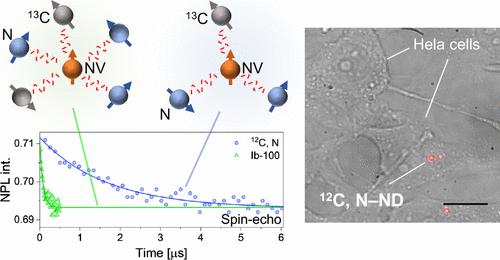Keisuke Oshimi, Hitoshi Ishiwata, Hiromu Nakashima, Sara Mandić, Hina Kobayashi, Minori Teramoto, Hirokazu Tsuji, Yoshiki Nishibayashi, Yutaka Shikano, Toshu An, Masazumi Fujiwara
求助PDF
{"title":"明亮的量子级荧光纳米金刚石","authors":"Keisuke Oshimi, Hitoshi Ishiwata, Hiromu Nakashima, Sara Mandić, Hina Kobayashi, Minori Teramoto, Hirokazu Tsuji, Yoshiki Nishibayashi, Yutaka Shikano, Toshu An, Masazumi Fujiwara","doi":"10.1021/acsnano.4c03424","DOIUrl":null,"url":null,"abstract":"Optically accessible spin-active nanomaterials are promising as quantum nanosensors for probing biological samples. However, achieving bioimaging-level brightness and high-quality spin properties for these materials is challenging and hinders their application in quantum biosensing. Here, we demonstrate bright fluorescent nanodiamonds (NDs) containing 0.6–1.3-ppm negatively charged nitrogen-vacancy (NV) centers by spin-environment engineering via enriching spin-less <sup>12</sup>C-carbon isotopes and reducing substitutional nitrogen spin impurities. The NDs, readily introduced into cultured cells, exhibited improved optically detected magnetic resonance (ODMR) spectra; peak splitting (<i>E</i>) was reduced by 2–3 MHz, and microwave excitation power required was 20 times lower to achieve a 3% ODMR contrast, comparable to that of conventional type-Ib NDs. They show average spin-relaxation times of <i>T</i><sub>1</sub> = 0.68 ms and <i>T</i><sub>2</sub> = 3.2 μs (1.6 ms and 5.4 μs maximum) that were 5- and 11-fold longer than those of type-Ib, respectively. Additionally, the extended <i>T</i><sub>2</sub> relaxation times of these NDs enable shot-noise-limited temperature measurements with a sensitivity of approximately <i></i><span style=\"color: inherit;\"></span><span data-mathml='<math xmlns=\"http://www.w3.org/1998/Math/MathML\" display=\"inline\"><mn>0.28</mn><mspace width=\"0.25em\" /><mi mathvariant=\"normal\">K</mi><mo>/</mo><msqrt><mi>Hz</mi></msqrt></math>' role=\"presentation\" style=\"position: relative;\" tabindex=\"0\"><nobr aria-hidden=\"true\"><span style=\"width: 5.685em; display: inline-block;\"><span style=\"display: inline-block; position: relative; width: 5.173em; height: 0px; font-size: 110%;\"><span style=\"position: absolute; clip: rect(1.423em, 1005.17em, 3.014em, -999.997em); top: -2.554em; left: 0em;\"><span><span style=\"font-family: STIXMathJax_Main;\">0.28</span><span style=\"height: 0em; vertical-align: 0em; width: 0.287em; display: inline-block; overflow: hidden;\"></span><span style=\"font-family: STIXMathJax_Main;\">K<span style=\"display: inline-block; overflow: hidden; height: 1px; width: 0.003em;\"></span></span><span style=\"font-family: STIXMathJax_Main;\">/</span><span><span style=\"display: inline-block; position: relative; width: 2.105em; height: 0px;\"><span style=\"position: absolute; clip: rect(3.128em, 1001.14em, 4.151em, -999.997em); top: -3.974em; left: 0.912em;\"><span><span style=\"font-family: STIXMathJax_Main;\">Hz</span></span><span style=\"display: inline-block; width: 0px; height: 3.98em;\"></span></span><span style=\"position: absolute; clip: rect(3.526em, 1001.2em, 3.923em, -999.997em); top: -4.599em; left: 0.912em;\"><span style=\"display: inline-block; position: relative; width: 1.196em; height: 0px;\"><span style=\"position: absolute; font-family: STIXMathJax_Symbols; top: -3.974em; left: 0em;\">⎯<span style=\"display: inline-block; width: 0px; height: 3.98em;\"></span></span><span style=\"position: absolute; font-family: STIXMathJax_Symbols; top: -3.974em; left: 0.855em;\">⎯<span style=\"display: inline-block; width: 0px; height: 3.98em;\"></span></span><span style=\"font-family: STIXMathJax_Symbols; position: absolute; top: -3.974em; left: 0.23em;\">⎯<span style=\"display: inline-block; width: 0px; height: 3.98em;\"></span></span><span style=\"font-family: STIXMathJax_Symbols; position: absolute; top: -3.974em; left: 0.401em;\">⎯<span style=\"display: inline-block; width: 0px; height: 3.98em;\"></span></span><span style=\"font-family: STIXMathJax_Symbols; position: absolute; top: -3.974em; left: 0.628em;\">⎯<span style=\"display: inline-block; width: 0px; height: 3.98em;\"></span></span></span><span style=\"display: inline-block; width: 0px; height: 3.98em;\"></span></span><span style=\"position: absolute; clip: rect(2.844em, 1000.97em, 4.435em, -999.997em); top: -3.974em; left: 0em;\"><span style=\"font-family: STIXMathJax_Main;\">√</span><span style=\"display: inline-block; width: 0px; height: 3.98em;\"></span></span></span></span></span><span style=\"display: inline-block; width: 0px; height: 2.56em;\"></span></span></span><span style=\"display: inline-block; overflow: hidden; vertical-align: -0.372em; border-left: 0px solid; width: 0px; height: 1.503em;\"></span></span></nobr><span role=\"presentation\"><math display=\"inline\" xmlns=\"http://www.w3.org/1998/Math/MathML\"><mn>0.28</mn><mspace width=\"0.25em\"></mspace><mi mathvariant=\"normal\">K</mi><mo>/</mo><msqrt><mi>Hz</mi></msqrt></math></span></span><script type=\"math/mml\"><math display=\"inline\"><mn>0.28</mn><mspace width=\"0.25em\"></mspace><mi mathvariant=\"normal\">K</mi><mo>/</mo><msqrt><mi>Hz</mi></msqrt></math></script>. The combination of bulk-like NV spin properties and enhanced fluorescence significantly improves the sensitivity of ND-based quantum sensors for biological applications.","PeriodicalId":21,"journal":{"name":"ACS Nano","volume":"37 1","pages":""},"PeriodicalIF":15.8000,"publicationDate":"2024-12-16","publicationTypes":"Journal Article","fieldsOfStudy":null,"isOpenAccess":false,"openAccessPdf":"","citationCount":"0","resultStr":"{\"title\":\"Bright Quantum-Grade Fluorescent Nanodiamonds\",\"authors\":\"Keisuke Oshimi, Hitoshi Ishiwata, Hiromu Nakashima, Sara Mandić, Hina Kobayashi, Minori Teramoto, Hirokazu Tsuji, Yoshiki Nishibayashi, Yutaka Shikano, Toshu An, Masazumi Fujiwara\",\"doi\":\"10.1021/acsnano.4c03424\",\"DOIUrl\":null,\"url\":null,\"abstract\":\"Optically accessible spin-active nanomaterials are promising as quantum nanosensors for probing biological samples. However, achieving bioimaging-level brightness and high-quality spin properties for these materials is challenging and hinders their application in quantum biosensing. Here, we demonstrate bright fluorescent nanodiamonds (NDs) containing 0.6–1.3-ppm negatively charged nitrogen-vacancy (NV) centers by spin-environment engineering via enriching spin-less <sup>12</sup>C-carbon isotopes and reducing substitutional nitrogen spin impurities. The NDs, readily introduced into cultured cells, exhibited improved optically detected magnetic resonance (ODMR) spectra; peak splitting (<i>E</i>) was reduced by 2–3 MHz, and microwave excitation power required was 20 times lower to achieve a 3% ODMR contrast, comparable to that of conventional type-Ib NDs. They show average spin-relaxation times of <i>T</i><sub>1</sub> = 0.68 ms and <i>T</i><sub>2</sub> = 3.2 μs (1.6 ms and 5.4 μs maximum) that were 5- and 11-fold longer than those of type-Ib, respectively. Additionally, the extended <i>T</i><sub>2</sub> relaxation times of these NDs enable shot-noise-limited temperature measurements with a sensitivity of approximately <i></i><span style=\\\"color: inherit;\\\"></span><span data-mathml='<math xmlns=\\\"http://www.w3.org/1998/Math/MathML\\\" display=\\\"inline\\\"><mn>0.28</mn><mspace width=\\\"0.25em\\\" /><mi mathvariant=\\\"normal\\\">K</mi><mo>/</mo><msqrt><mi>Hz</mi></msqrt></math>' role=\\\"presentation\\\" style=\\\"position: relative;\\\" tabindex=\\\"0\\\"><nobr aria-hidden=\\\"true\\\"><span style=\\\"width: 5.685em; display: inline-block;\\\"><span style=\\\"display: inline-block; position: relative; width: 5.173em; height: 0px; font-size: 110%;\\\"><span style=\\\"position: absolute; clip: rect(1.423em, 1005.17em, 3.014em, -999.997em); top: -2.554em; left: 0em;\\\"><span><span style=\\\"font-family: STIXMathJax_Main;\\\">0.28</span><span style=\\\"height: 0em; vertical-align: 0em; width: 0.287em; display: inline-block; overflow: hidden;\\\"></span><span style=\\\"font-family: STIXMathJax_Main;\\\">K<span style=\\\"display: inline-block; overflow: hidden; height: 1px; width: 0.003em;\\\"></span></span><span style=\\\"font-family: STIXMathJax_Main;\\\">/</span><span><span style=\\\"display: inline-block; position: relative; width: 2.105em; height: 0px;\\\"><span style=\\\"position: absolute; clip: rect(3.128em, 1001.14em, 4.151em, -999.997em); top: -3.974em; left: 0.912em;\\\"><span><span style=\\\"font-family: STIXMathJax_Main;\\\">Hz</span></span><span style=\\\"display: inline-block; width: 0px; height: 3.98em;\\\"></span></span><span style=\\\"position: absolute; clip: rect(3.526em, 1001.2em, 3.923em, -999.997em); top: -4.599em; left: 0.912em;\\\"><span style=\\\"display: inline-block; position: relative; width: 1.196em; height: 0px;\\\"><span style=\\\"position: absolute; font-family: STIXMathJax_Symbols; top: -3.974em; left: 0em;\\\">⎯<span style=\\\"display: inline-block; width: 0px; height: 3.98em;\\\"></span></span><span style=\\\"position: absolute; font-family: STIXMathJax_Symbols; top: -3.974em; left: 0.855em;\\\">⎯<span style=\\\"display: inline-block; width: 0px; height: 3.98em;\\\"></span></span><span style=\\\"font-family: STIXMathJax_Symbols; position: absolute; top: -3.974em; left: 0.23em;\\\">⎯<span style=\\\"display: inline-block; width: 0px; height: 3.98em;\\\"></span></span><span style=\\\"font-family: STIXMathJax_Symbols; position: absolute; top: -3.974em; left: 0.401em;\\\">⎯<span style=\\\"display: inline-block; width: 0px; height: 3.98em;\\\"></span></span><span style=\\\"font-family: STIXMathJax_Symbols; position: absolute; top: -3.974em; left: 0.628em;\\\">⎯<span style=\\\"display: inline-block; width: 0px; height: 3.98em;\\\"></span></span></span><span style=\\\"display: inline-block; width: 0px; height: 3.98em;\\\"></span></span><span style=\\\"position: absolute; clip: rect(2.844em, 1000.97em, 4.435em, -999.997em); top: -3.974em; left: 0em;\\\"><span style=\\\"font-family: STIXMathJax_Main;\\\">√</span><span style=\\\"display: inline-block; width: 0px; height: 3.98em;\\\"></span></span></span></span></span><span style=\\\"display: inline-block; width: 0px; height: 2.56em;\\\"></span></span></span><span style=\\\"display: inline-block; overflow: hidden; vertical-align: -0.372em; border-left: 0px solid; width: 0px; height: 1.503em;\\\"></span></span></nobr><span role=\\\"presentation\\\"><math display=\\\"inline\\\" xmlns=\\\"http://www.w3.org/1998/Math/MathML\\\"><mn>0.28</mn><mspace width=\\\"0.25em\\\"></mspace><mi mathvariant=\\\"normal\\\">K</mi><mo>/</mo><msqrt><mi>Hz</mi></msqrt></math></span></span><script type=\\\"math/mml\\\"><math display=\\\"inline\\\"><mn>0.28</mn><mspace width=\\\"0.25em\\\"></mspace><mi mathvariant=\\\"normal\\\">K</mi><mo>/</mo><msqrt><mi>Hz</mi></msqrt></math></script>. The combination of bulk-like NV spin properties and enhanced fluorescence significantly improves the sensitivity of ND-based quantum sensors for biological applications.\",\"PeriodicalId\":21,\"journal\":{\"name\":\"ACS Nano\",\"volume\":\"37 1\",\"pages\":\"\"},\"PeriodicalIF\":15.8000,\"publicationDate\":\"2024-12-16\",\"publicationTypes\":\"Journal Article\",\"fieldsOfStudy\":null,\"isOpenAccess\":false,\"openAccessPdf\":\"\",\"citationCount\":\"0\",\"resultStr\":null,\"platform\":\"Semanticscholar\",\"paperid\":null,\"PeriodicalName\":\"ACS Nano\",\"FirstCategoryId\":\"88\",\"ListUrlMain\":\"https://doi.org/10.1021/acsnano.4c03424\",\"RegionNum\":1,\"RegionCategory\":\"材料科学\",\"ArticlePicture\":[],\"TitleCN\":null,\"AbstractTextCN\":null,\"PMCID\":null,\"EPubDate\":\"\",\"PubModel\":\"\",\"JCR\":\"Q1\",\"JCRName\":\"CHEMISTRY, MULTIDISCIPLINARY\",\"Score\":null,\"Total\":0}","platform":"Semanticscholar","paperid":null,"PeriodicalName":"ACS Nano","FirstCategoryId":"88","ListUrlMain":"https://doi.org/10.1021/acsnano.4c03424","RegionNum":1,"RegionCategory":"材料科学","ArticlePicture":[],"TitleCN":null,"AbstractTextCN":null,"PMCID":null,"EPubDate":"","PubModel":"","JCR":"Q1","JCRName":"CHEMISTRY, MULTIDISCIPLINARY","Score":null,"Total":0}
引用次数: 0
引用
批量引用


 求助内容:
求助内容: 应助结果提醒方式:
应助结果提醒方式:


